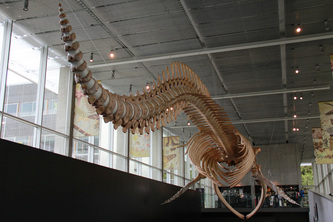Lunge-feeding Blue Whale,
Vancouver, british columbia
"the largest skeleton exhibit in the world suspended without external armature"
-UBC Public Affairs
-UBC Public Affairs
In 1987, a 26m female blue whale washed up on a remote beach on the northwest coast of Prince Edward Island and was buried. Twenty years later, the University of British Columbia acquired rights to recover the specimen, which was intended to become the main exhibit within the Beaty Biodiversity Museum's main glass atrium, showcasing the awesome biodiversity held within our oceans. Cetacea was asked to lead this challenging endeavour.
We encountered substantial challenges right from the start, beginning with the fact that the 150 tonne carcass had hardly decayed and had sustained significant skeletal damage during its 20 year burial (see images from the recovery dig on YouTube). This was a multi-faceted project with media and educational focus throughout the stages of cleaning the bones, bone repair and preparation, articulation design and articulation through to final installation of the skeleton. The entire project was completed over two and a half years and some of the process can be seen on Discovery's feature-length documentary, Raising Big Blue.
This is the largest internally supported suspended skeleton in the world, mounted dynamically in Cetacea's signature style. The armature is hidden with artistically stylized cartilege. Its articulation was carried out scientifically, based on careful documentation in the field and consultation with research specialists to ensure anatomical accuracy. All missing bones and restored areas have been replicated and painted to match the original bone. Damage to the skeleton has been repaired with the exception of her left flipper, which tells an interesting story.
She has been postured, jaws partially agape, with flippers extended and guiding her through the water as she gives a powerful thrust of her tail. Imagine this largest creature known to live on earth just completing a surface lunge-feed, rolled over on her right side and about to descend to the depths below, engaged in the world's largest known biodynamic activity.
Although the cause of her death remains unknown, evidence from her substantially damaged skeleton suggests that she was likely struck by a ship, one of the main threats to large cetaceans.
This exhibit has drawn thousands of visitors to the Beaty Biodiversity Museum at UBC since it opened in 2010. To learn more about this project and to visit this world-renowned exhibit and natural history museum, please visit the Beaty Biodiversity Museum.
Photos (from left): Mike and Bob de Roos during the installation; Mike with film crew; Discovery documentary cast (Bob deRoos, Pierre-Yves Daoust, Sandra Keough, Andrew Trites, John-Pietre, Jr., Michi Main, Mike deRoos, Jesse McBeath); Blue whale skeleton from below
Skeletons > Blue whale















